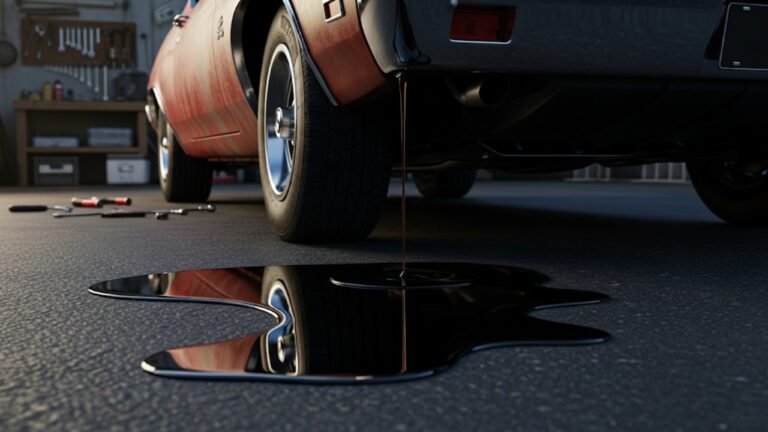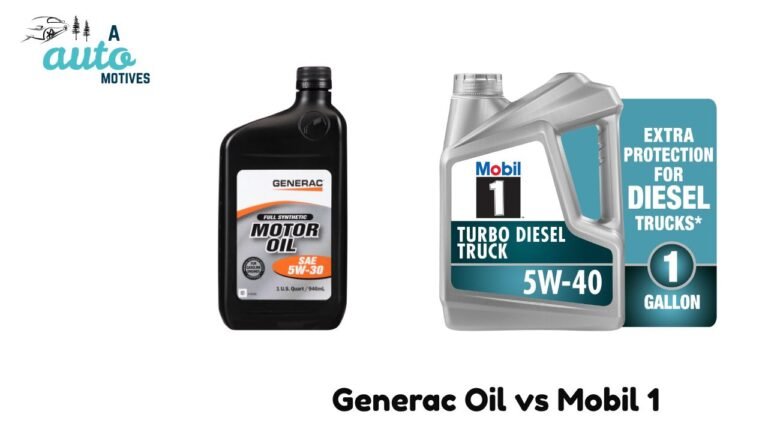Why Is My Car Leaking Oil in Cold Weather?

You step outside on a freezing morning, breath fogging the air, coffee in one hand, keys in the other. As you reach your car, ready to head out for the day, you spot it—a dark puddle of oil on the driveway. Your heart sinks.
“Why is my car leaking oil in cold weather?”
You’re not alone. This is a frustrating but common issue during winter. It’s like your car catches a cold when the temperature drops. Oil leaks are never ideal, but cold weather brings out the worst in them.
In this article, we’ll explore why oil leaks happen more in winter, what parts are usually affected, and what you can do to fix the problem for good. We’ll also talk about some signs to watch out for, when to worry, and how to prevent leaks from returning.
Let’s dive in—with gloves on, of course.
In This Article
- 1 The Relationship Between Cold Weather and Oil Leaks
- 2 Common Causes of Oil Leaks in Cold Weather
- 3 What Does an Oil Leak Look Like in Winter?
- 4 Why Leaks Get Worse in Winter
- 5 Is It Safe to Drive a Car That’s Leaking Oil?
- 6 How to Fix a Car Leaking Oil in Cold Weather
- 7 How to Prevent Future Leaks During Winter
- 8 DIY or Mechanic: Who Should Handle the Leak?
- 9 Emotional Toll: The Winter Breakdown Blues
- 10 Troubleshooting Checklist: Is Your Car Really Leaking Oil?
- 11 Related Issues That Mimic an Oil Leak
- 12 5 Signs You Should Address an Oil Leak Immediately
- 13 FAQs About Car Leaking Oil in Cold Weather
- 13.1 1. Why does my car leak oil only when it’s cold?
- 13.2 2. Is it okay to use stop-leak additives?
- 13.3 3. Can an oil leak cause engine damage?
- 13.4 4. How much does it cost to fix an oil leak?
- 13.5 5. Should I warm up my car in winter to prevent leaks?
- 13.6 6. Can I still pass inspection with a leaking engine?
- 13.7 7. What oil is best for cold weather?
- 13.8 8. Will driving short distances in winter make leaks worse?
- 14 Conclusion: Be Kind to Your Car This Winter
The Relationship Between Cold Weather and Oil Leaks

Here’s why:
-
Rubber seals shrink when exposed to extreme cold, allowing oil to escape.
-
Engine oil thickens in freezing temperatures, putting more pressure on gaskets and seals.
-
Condensation can freeze and crack components over time.
-
Old or brittle parts are more likely to fail when the temperature swings.
In other words, cold weather stresses your car’s weakest links.
Common Causes of Oil Leaks in Cold Weather
Let’s break it down. Here are the main culprits behind a car leaking oil in cold weather:
1. Worn Out Valve Cover Gasket
Your valve cover gasket keeps oil inside the engine. Over time, especially with cold cycles, this gasket hardens and cracks. When it’s cold out, the rubber shrinks even more—leading to a slow drip or a big mess.
Signs:
-
Oil stains near the top of the engine
-
Burning oil smell
-
Visible leaks after starting the car
2. Damaged Oil Pan Gasket
The oil pan sits at the bottom of your engine. Its gasket takes a beating every time you drive. In winter, it becomes more brittle and less flexible.
Signs:
-
A large puddle under the car
-
Low oil levels
-
Smoke from under the hood
3. Cracked Oil Filter Housing or Loose Filter
If you recently changed your oil and it’s leaking now, the cold may have compromised the seal on the filter or housing.
Signs:
-
Leaks right after an oil change
-
Drips coming from near the oil filter
-
Hissing or pressure release noises
4. Oil Pressure Sensor Leaks
The oil pressure sensor can also fail during colder months. Its o-ring may shrink and cause a leak.
Signs:
-
Oil around the sensor
-
Erratic oil pressure readings
-
Dashboard warning lights
What Does an Oil Leak Look Like in Winter?
You might notice:
-
A dark brown or amber puddle on snow or concrete
-
Sticky, thick oil near the bottom of your engine
-
Oil streaks on your driveway that reappear after every trip
Table: Identifying Oil Leaks by Appearance
| Leak Location | Color/Texture | Likely Cause |
|---|---|---|
| Front of engine | Amber, runny | Valve cover gasket |
| Under the car (center) | Dark brown, thick | Oil pan gasket or drain plug |
| Near the oil filter | Medium brown, greasy | Filter housing or O-ring |
| Near firewall | Thin and black | Oil pressure sensor or head gasket |
Why Leaks Get Worse in Winter
Let’s get personal for a moment.
Last December, I noticed a new oil patch every morning. First, it was small—like a coin. Then, one day, after a night of deep freeze, it grew as big as a dinner plate. That’s when I realized: cold weather wasn’t just exposing the leak—it was making it worse.
Here’s why that happens:
-
Cold oil is thicker, which makes it harder to circulate. This increases oil pressure, pushing against weak seals.
-
When your car starts warming up, metal expands quickly, but rubber lags behind. This mismatch creates gaps.
-
Frozen components can crack or split suddenly, especially if there’s trapped moisture.
It’s not just one problem—it’s a chain reaction. And winter is the spark.
Is It Safe to Drive a Car That’s Leaking Oil?
Short answer: sometimes, but not for long.
If the leak is minor, and you top up the oil, you might be able to drive short distances. But if you keep driving without fixing it, you risk:
-
Engine damage due to low oil
-
Overheating from poor lubrication
-
Oil on belts or electrical parts, leading to secondary issues
I once ignored a leak for two weeks. It ended with a tow truck ride and a $900 repair bill. So trust me—it’s not worth the gamble.
How to Fix a Car Leaking Oil in Cold Weather
Let’s roll up our sleeves. Fixing an oil leak doesn’t always mean a costly trip to the mechanic—though sometimes it does. Here are your options:
1. Inspect and Tighten Components
Cold temperatures can loosen bolts. Check:
-
Oil filter
-
Drain plug
-
Valve cover bolts
Tighten gently. Don’t overdo it—you might strip the threads.
2. Use High-Mileage or Cold-Weather Oil
These oils have additives that condition old seals and flow better in low temperatures. Look for oil marked with:
-
“5W-30” or “0W-20”
-
“High mileage”
-
“For winter use”
3. Replace Gaskets or Seals
If the gasket is cracked, no amount of wishful thinking will fix it. You’ll need to replace it. Common ones include:
-
Valve cover gasket
-
Oil pan gasket
-
Front main seal
You can do this at home with a repair manual and basic tools, or have a trusted mechanic handle it.
4. Add a Stop-Leak Product (Temporary Fix)
Some products help swell rubber seals temporarily. They’re not a long-term solution, but can buy you time during the cold months.
Use only:
-
Reputable brands like Lucas or BlueDevil
-
Products made specifically for oil system leaks
Avoid using stop-leak if your engine is under warranty—it might void it.
How to Prevent Future Leaks During Winter
Prevention is better than cure, right?
Bullet List: Tips to Avoid Oil Leaks in Winter
-
Warm up your engine before driving to reduce pressure surges
-
Park in a garage or covered space when possible
-
Use rubber-safe conditioners or high-mileage oil blends
-
Replace old gaskets before winter starts
-
Avoid over-tightening parts during oil changes
-
Check oil levels weekly in cold months
These small habits can save you big bucks—and a whole lot of stress.
DIY or Mechanic: Who Should Handle the Leak?
If you’re handy and have the right tools, some oil leaks are manageable at home. But let’s be honest—not everyone wants to crawl under a cold car in January with frozen fingers and a flashlight.
Here’s a quick comparison:
| Task | DIY-Friendly | Mechanic Recommended |
|---|---|---|
| Tightening oil filter or drain plug | ✅ | – |
| Switching to winter-grade oil | ✅ | – |
| Replacing valve cover gasket | ✅ (if skilled) | ✅ |
| Replacing oil pan gasket | ❌ (requires lifting engine or subframe) | ✅ |
| Diagnosing high-pressure leaks | ❌ | ✅ |
If your leak is small, your oil level is stable, and you enjoy the challenge, give it a go. But if the engine bay looks like a crime scene or the leak is near electrical parts—call in the pros. Don’t risk it.
Emotional Toll: The Winter Breakdown Blues
It’s not just about money or mechanics. A leaking car in winter hits you in the feels.
It’s the stress of spotting that oil stain every morning. The worry of a breakdown on a snowy road. The guilt of driving a polluting, malfunctioning machine.
I remember sitting in my cold car, wrapped in a hoodie, wondering if I’d make it to work—or get stranded on the side of the highway. It messes with your peace of mind.
But here’s the thing: once you fix it, the relief is massive. You start trusting your car again. And winter becomes a little less bitter.
So give your ride the care it deserves. It’s not just a machine—it’s your cold-weather companion.
Troubleshooting Checklist: Is Your Car Really Leaking Oil?
Before you panic, double-check with this step-by-step guide.
Quick Troubleshooting List:
-
Do you see an oil light on the dash?
-
Is the oil level dropping between checks?
-
Are the leaks fresh, or could they be old stains?
-
Does the leak happen only after driving?
-
Are there drips from the filter, gasket, or oil pan?
Sometimes, melted snow mixed with grime can look like oil. Rub it with a napkin—real oil feels slippery and smells sharp. Water won’t.
Related Issues That Mimic an Oil Leak
Not all leaks in winter are oil leaks. Let’s decode some copycats:
-
Transmission fluid: Red or brown, and leaks near the middle or rear.
-
Coolant (antifreeze): Green, orange, or pink. Slightly sweet smell.
-
Water: Often from condensation or snowmelt. Clear and odorless.
-
️ Power steering fluid: Slick and reddish. Usually leaks near front wheels.
Knowing the difference saves you from unnecessary panic—or misdiagnosis.
5 Signs You Should Address an Oil Leak Immediately
Not all leaks need emergency intervention, but some do. Watch for these red flags:
-
You’re topping up oil more than once a week.
-
There’s a burning smell from the engine bay.
-
Smoke rises from under the hood.
-
⚠️ The oil pressure warning light is flashing.
-
The leak gets worse every day.
If you see any of these, stop driving and get your car inspected. Better to fix it now than replace the engine later.
FAQs About Car Leaking Oil in Cold Weather
Here are the most frequently asked questions I get from friends, family, and frustrated winter drivers:
1. Why does my car leak oil only when it’s cold?
Because cold makes rubber seals shrink and oil thicker. This combo causes pressure buildup and tiny cracks where oil can escape.
2. Is it okay to use stop-leak additives?
Yes, but only as a temporary fix. They can swell gaskets and reduce leaks, but overuse may clog oil passages. Use sparingly.
3. Can an oil leak cause engine damage?
Absolutely. If oil levels drop too low, your engine won’t be lubricated properly, leading to overheating and internal wear—or total failure.
4. How much does it cost to fix an oil leak?
It depends. Minor fixes (like replacing a valve cover gasket) may cost $100–$250. Major repairs like an oil pan gasket could be $400–$800 or more.
5. Should I warm up my car in winter to prevent leaks?
Yes. Letting the engine idle for 2–3 minutes helps oil flow properly and reduces pressure spikes on cold components.
6. Can I still pass inspection with a leaking engine?
Most states allow minor leaks, but if it’s dripping onto exhaust components or causing smoke, it could fail inspection.
7. What oil is best for cold weather?
Use synthetic oils like 0W-20 or 5W-30. They flow better in cold temperatures and reduce strain on your engine.
8. Will driving short distances in winter make leaks worse?
Yes. Short trips mean the engine doesn’t fully warm up, so seals stay contracted and pressure builds. Longer trips are better for health.
Conclusion: Be Kind to Your Car This Winter
Dealing with a car leaking oil in cold weather isn’t fun. It’s messy, inconvenient, and often expensive. But ignoring it can lead to bigger headaches—and costlier repairs.
The good news? Once you understand what causes winter leaks and how to fix them, you’re back in control.
Here’s your game plan:
-
Identify where the leak is coming from.
-
Use winter-grade oils and condition your seals.
-
Repair or replace the faulty part before it gets worse.
-
And if in doubt—call a pro.
Cars aren’t perfect, especially in cold climates. But with a little care and attention, yours can survive the winter without a drip.
Bundle up, top off that oil, and drive safe.






